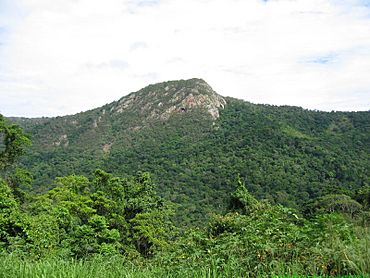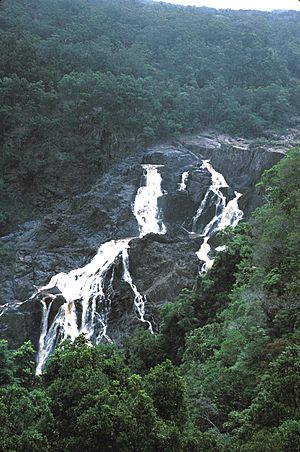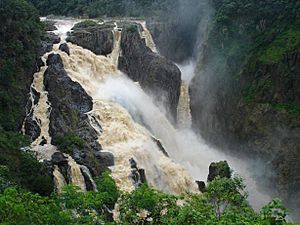Barron Gorge National Park facts for kids
Quick facts for kids Barron Gorge National ParkQueensland |
|
|---|---|
|
IUCN Category II (National Park)
|
|

Glacier Rock, 2009
|
|
| Nearest town or city | Cairns |
| Established | 1940 |
| Area | 28 km2 (10.8 sq mi) |
| Managing authorities | Queensland Parks and Wildlife Service |
| Website | Barron Gorge National Park |
| See also | Protected areas of Queensland |
Barron Gorge National Park is a beautiful protected area in Queensland, Australia. It is found near the city of Cairns and is mostly within a place called Barron Gorge. This park is famous for its stunning waterfalls and lush rainforest. It is a great place to explore nature and learn about the local wildlife.
Contents
Exploring the Park
Barron Gorge National Park is about 2 km from the town of Kuranda. It is also part of the Wet Tropics World Heritage Area. This means it is a very special place recognized around the world for its natural beauty.
Skyrail and Railway
One exciting way to see the park is by riding the Skyrail Rainforest Cableway. This cableway is 7.5 km long and glides high above the rainforest. It gives you amazing views of the gorge and the trees below. The Skyrail has won many awards for being a great way to experience the rainforest.
You can also take the Kuranda Scenic Railway through the park. This historic train line passes right through the gorge. There is a station at Barron Falls, where you can get off and see the incredible waterfalls. Two trains travel from Cairns to Kuranda and back every day. You can even see an old weir (a small dam) built in 1934 from the station lookout.
Amazing Landforms

The Barron Gorge was formed by the Barron River. The river flows over the edge of the Atherton Tablelands, creating the gorge. The most famous feature is Barron Falls, where water cascades down 265 m into the gorge.
There are also two other waterfalls in the park. These are Stoney Creek Falls and Surprise Creek Falls. They are found on smaller streams that flow into the Barron River. The sides of the gorge are very steep, some even at a 45-degree angle. Building the railway here was very difficult and dangerous. Sadly, 23 lives were lost during its construction.
A Look Back in Time
In 1885, an explorer named Archibald Meston visited Barron Falls. He described the powerful floodwaters as rushing "like wild horses." He said the air currents from the waterfall were so strong they made tree branches wave high above. He even felt the rocks shake from the force of the water.
Hydroelectric Power
In 1935, the water from the Barron River was used to make electricity. This was done at the Barron Gorge Hydroelectric Power Station. It was the first place in Queensland to generate hydroelectric power. An underground power station was built inside the cliff, 200 m from the base of Barron Falls. Water flowed through pipes to spin turbines, which made electricity.
Traditional Owners
The Djabugandji Bama people are the Traditional Owners of this area. They call it Djirri Nyundu Nyrrumba. This includes Barron Gorge National Park. On December 17, 2004, ownership of the park was returned to its Traditional Owners. This was the first park in Queensland to have its native title recognized. Visitors can still enjoy the park, and the Aboriginal people can hold their traditional religious ceremonies there.
Plants and Animals
The park is home to many interesting plants and animals. At the bottom of the gorge, you can see Bird's-nest ferns and elkhorn ferns. These grow among trees like Candlenut, Corkwood, Native olive, and False Red Sandalwood.
Birdlife
Barron Gorge National Park is part of the Wooroonooran Important Bird Area. This means it is a very important place for many bird species. Some birds that live here are found only in Queensland's Wet Tropics. You might often see Noisy pittas and orange-footed scrubfowl. Sometimes, the large southern cassowary is also spotted in the southern part of the park.
Night Animals
Many animals in the park are active at night. These include different types of possums and flying foxes. You might also be lucky enough to see a Lumholtz's tree-kangaroo or a northern quoll.
See also
 In Spanish: Parque nacional Garganta Barron para niños
In Spanish: Parque nacional Garganta Barron para niños



